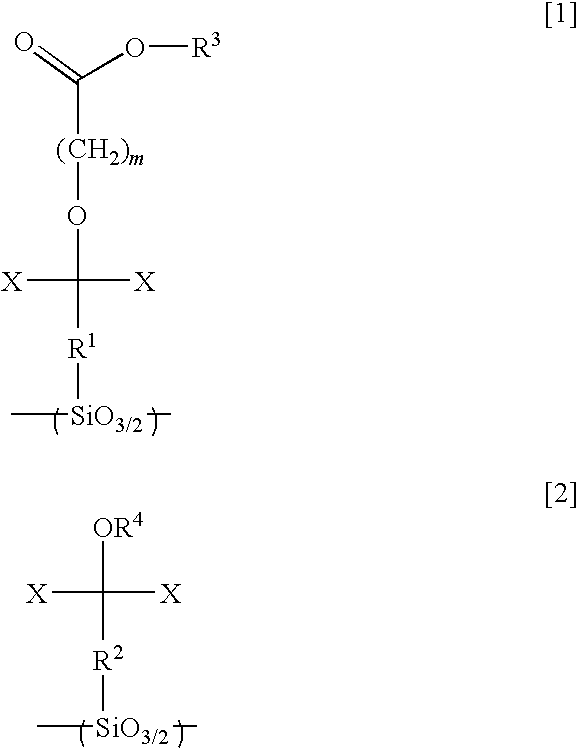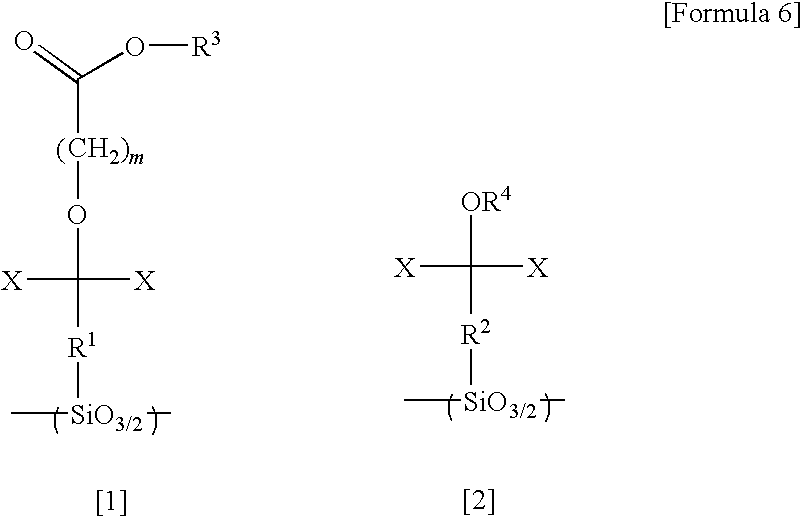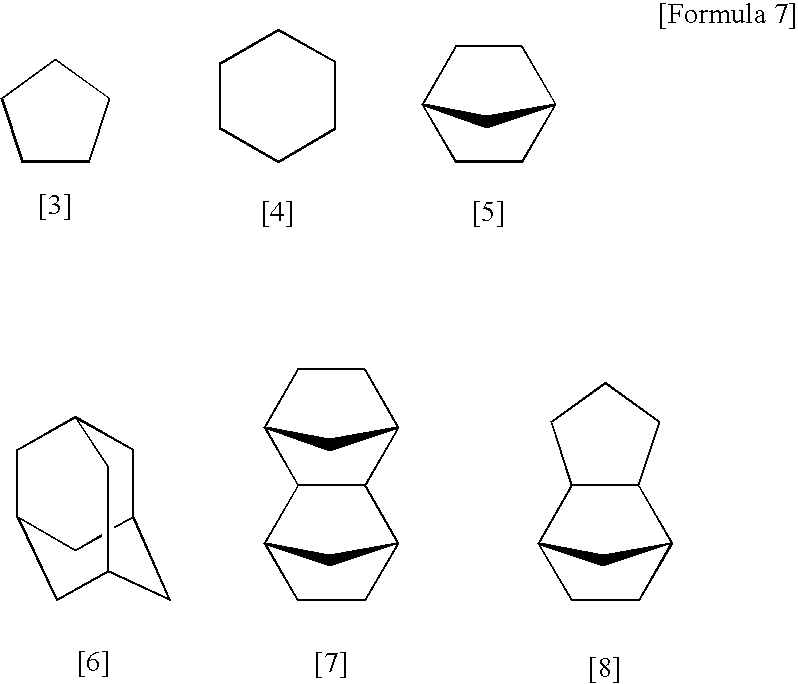Silsesquioxane resin, positive resist composition, resist laminate, and method of forming resist pattern
a technology of silicon dioxide and silicon dioxide, applied in the direction of photosensitive materials, instruments, photomechanical equipment, etc., can solve the problems of poor transparency, large absorption, and troublesome pattern collapse, and achieve the effect of high transparency
- Summary
- Abstract
- Description
- Claims
- Application Information
AI Technical Summary
Benefits of technology
Problems solved by technology
Method used
Image
Examples
synthesis example 1
[0224]20.0 g of hexafluoroisopropanol norbornene, 0.02 g of a 20% by weight isopropanol solution of chloroplatinic acid, and 30 g of tetrahydrofuran were poured into a 200 ml flask, and the mixture was heated to 70° C. with stirring. 9.2 g of tetrachlorosilane was then added dropwise to the solution over a period of 15 minutes. Following stirring for a further 5 hours, the mixture was distilled, yielding 15 g of hexafluoroisopropanol norbornyltrichlorosilane (a Si-containing monomer represented by the formula [29] shown below).
[0225]Next, 10 g of the thus obtained Si-containing monomer, 10 g of toluene, 10 g of methyl isobutyl ketone, 1.0 g of potassium hydroxide, and 5 g of water were poured into a 200 ml flask and stirred for one hour. Subsequently, the solution was diluted with methyl isobutyl ketone, and washed with 0.1 N hydrochloric acid until the pH value fell to no more than 8. The thus obtained solution was then filtered, and stirred for 12 hours at 200° C., thus yielding a...
example 1
[0227]4 g of the polymer (x) obtained in the synthesis example 1 was dissolved in 75.9 g of ethyl lactate, and 0.12 g of triphenylsulfonium nonaflate and 0.008 g of tri-n-pentylamine were then added, thus forming a positive resist composition.
[0228]Next, using a solution generated by dissolving a novolak resin, produced by a condensation of m-cresol, p-cresol, and formalin in the presence of an oxalic acid catalyst, in an organic solvent as the lower resist material, this solution was applied to the surface of a silicon substrate using a spinner, and was then subjected to baking at 250° C. for 90 seconds, thus forming a lower resist layer with a film thickness of 300 nm.
[0229]The positive resist composition obtained above was then applied to the surface of the lower resist layer using a spinner, and was then prebaked and dried at 90° C. for 90 seconds, thus forming an upper resist layer of film thickness 100 nm, and completing formation of a resist laminate.
[0230]Subsequently, this ...
synthesis example 2
[0237]With the exception of replacing the 2-methyl-2-adamantylbromoacetate from the synthesis example 1 with 2-ethyl-2-adamantylbromoacetate, the same method as the synthesis example 1 was used to produce a polymer (x1), in which the 2-methyl-2-adamantyl group of the polymer (x) from the synthesis example 1 had been replaced with a 2-ethyl-2-adamantyl group.
PUM
| Property | Measurement | Unit |
|---|---|---|
| aspect ratio | aaaaa | aaaaa |
| aspect ratio | aaaaa | aaaaa |
| mol % | aaaaa | aaaaa |
Abstract
Description
Claims
Application Information
 Login to View More
Login to View More - R&D
- Intellectual Property
- Life Sciences
- Materials
- Tech Scout
- Unparalleled Data Quality
- Higher Quality Content
- 60% Fewer Hallucinations
Browse by: Latest US Patents, China's latest patents, Technical Efficacy Thesaurus, Application Domain, Technology Topic, Popular Technical Reports.
© 2025 PatSnap. All rights reserved.Legal|Privacy policy|Modern Slavery Act Transparency Statement|Sitemap|About US| Contact US: help@patsnap.com



